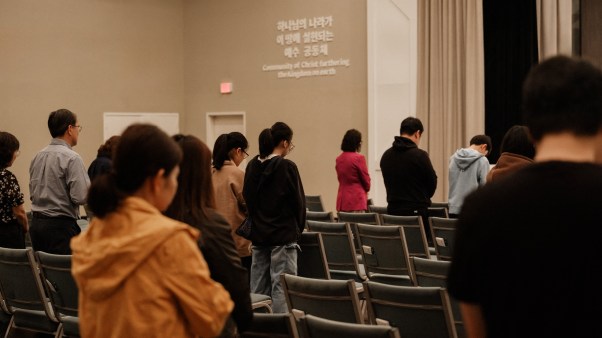I can think of few questions that have haunted pastors as much as this one: “What makes a worship gathering successful?”
It’s easy enough to offer up a theologically sound response, but the stressful frenzy of activity within church leadership meetings preceding the season of Easter suggests that these answers rarely satisfy. Even as many of us ministering in contemporary evangelical spaces prepare to lead our churches in worship and through the Word, we likely know the tension between quiet, faithful labor and attempts to sanctify our own ambitions. Many of us understand how difficult it can be to plan for the church we have while trying to ignore the thought of the church we desire. Bigger, louder, more unique content to push—definitions of success for the church and its gatherings start to look familiar, worldly, unimaginative.
This ministerial irony is often loudest during the season of Lent. While millions of believers all over the world begin to embark on a spiritual journey of quiet, strenuous preparation leading up to Easter, many of their pastors are assembling teams to facilitate grand ideas that might draw record-setting crowds. The “Super Bowl Sunday” of the modern church calendar is marked to proclaim the victory of Christ, but with that date comes very specific ideas of success and uniquely heavy burdens required to achieve them. Budgets skyrocket. The number of required volunteers jumps. The joyful Easter celebration for the congregation can feel more like an exhausted, finish-line collapse for the staff and teams that facilitate it.
This price is worth paying when the measure of success is simply “more.” After all, the surge in attendance around Easter is a real phenomenon, and that requires thoughtful preparation and appropriate strategizing. Some churches find the gloom and weight of the Lenten season to be an obstacle to their Easter plans, and dismiss it entirely. I have heard Lent referred to as “Catholic” by contemporary evangelicals, or labeled as the product of dying denominations and their antiquated liturgical traditions. After all, the year is new. People are hopeful. Why burden the beginning of their annual race with the heaviness of sustained introspection? Why ground the momentum of early Spring with difficult contemplation and risk spoiling the party in April?
Much of this thinking stems from the not unreasonable desire for a church that is culturally relevant. How can we hope to reach those who find themselves in a hurried, noisy world with a season of stillness and quiet? Internally, we might value the practices of confession and fasting, but how could these strange fires possibly spark hearts in a darkened world? Lest I sound like I’m shouting from a hypocritical pulpit, I assure you that in each context of my vocational ministry, this is a tension I’ve felt year after year in leading worship and planning services. The challenge of reconciling Easter preparation both as a follower and as a pastor is one I have failed in many times. For church leaders, somewhere along the way, the goal of being culturally relevant became separate and superior to the aim of being culturally resonant.
The celebration of Easter has come to mean something very specific: it’s when we play our loudest songs and feature our biggest and most frequent services of the year. Where our attention is directed, so too are our budgets and passions.
Eventually this approach is going to cause the goalposts to move significantly. Compared with the display of our Easter gatherings, the message embedded within them can start to dull. Many pastors I have spoken to have expressed the quiet shame of trying to wring something unique and special out of a story they feel has been told hundreds of times—and often told better at churches down the street or online. That might sound shocking to read as a layperson, but I suspect ministers who read this are at least familiar with the sentiment. Where success has meant ingenuity and spectacle, imaginations have become exhausted. Much like parents putting on a birthday party for their toddler, all the work involved leaves little room to pause and celebrate.
The Lent-averse impulses of Easter event planners are not wrong. The task of making Lent culturally relevant in this kind of environment is practically impossible. So be it! It is the strangeness of Lent—its stubborn slowness amid the year’s fresh rush of activity, its invitation to confession when pride and faith in self are at their highest—that makes it so powerful and potentially so resonant, in both the culture we are trying to reach and the culture we are fostering within our congregations.
 Alexandre Calame / National Gallery of Art Open Access
Alexandre Calame / National Gallery of Art Open AccessIt might seem like I am advocating for a diminished Easter celebration. Quite the opposite. It is the journey of Lent that places Easter in the brightest light. It is the countercultural movement offered in confession and sacrifice that makes the path that Christ walked for us so clear in our hearts and minds and pews. Of all Sundays, Easter should be the highest note we hit in our church calendars, not simply a weekend to survive with painted smiles and gritted teeth. It is joy blooming large. But without facing the reality of bondage, without staring a broken world in its face, of what value is Easter’s liberation? Without confronting the temptations of our flesh and the failures of our sins, what hope is there for inspiring redemptive imaginations with the story of the gospel? If we cannot slow ourselves and lighten our burdens enough to savor the gift of the Cross, why should we expect to effectively communicate to lost friends and family the joy of Christ’s resurrection?
If Easter has quietly lost some of its luster among pastors and leaders because of wayward expectations and rhythms, Lent can offer more than a corrective. It can provide us with a chance to rekindle a first love. In his book on the season, Great Lent, Alexander Schmemann writes:
The liturgical traditions of the Church, all its cycles and services, exist, first of all, in order to help us recover the vision and the taste of that new life which we so easily lose and betray, so that we may repent and return to it. How can we love and desire something we do not know? How can we put above everything else in our life something which we have not seen and enjoyed?
The countercultural nature of Lent is precisely the point. Lent is a spiritual cleanse ahead of a transformed way of living and being with God. In this season we have a chance to let false gods die so that Christ might rise high in us.
What makes a worship gathering successful? Surely it is one where Jesus is clearly presented, enjoyed, thanked, praised. It is one where all the hungry—guest and minister alike—can find rest at the table that the Lord has prepared. If we are willing to take the invitation Lent offers, to slow down and let go of errant ambitions or exhausting rhythms, we might encounter the kind of joy we have been longing for in the Easter celebration—the kind it was always meant to provide.
Caleb Saenz is pastor of spiritual formation at Alamo Community Church in San Antonio, Texas, where he and his family will be planting The Garden later this year. He is currently pursuing a degree at the Institute of Worship Studies in Jacksonville, Florida.
This article is part of New Life Rising which features articles and Bible study sessions reflecting on the meaning of Jesus’ death and resurrection. Learn more about this special issue that can be used during Lent, the Easter season, or any time of year at http://orderct.com/lent.











